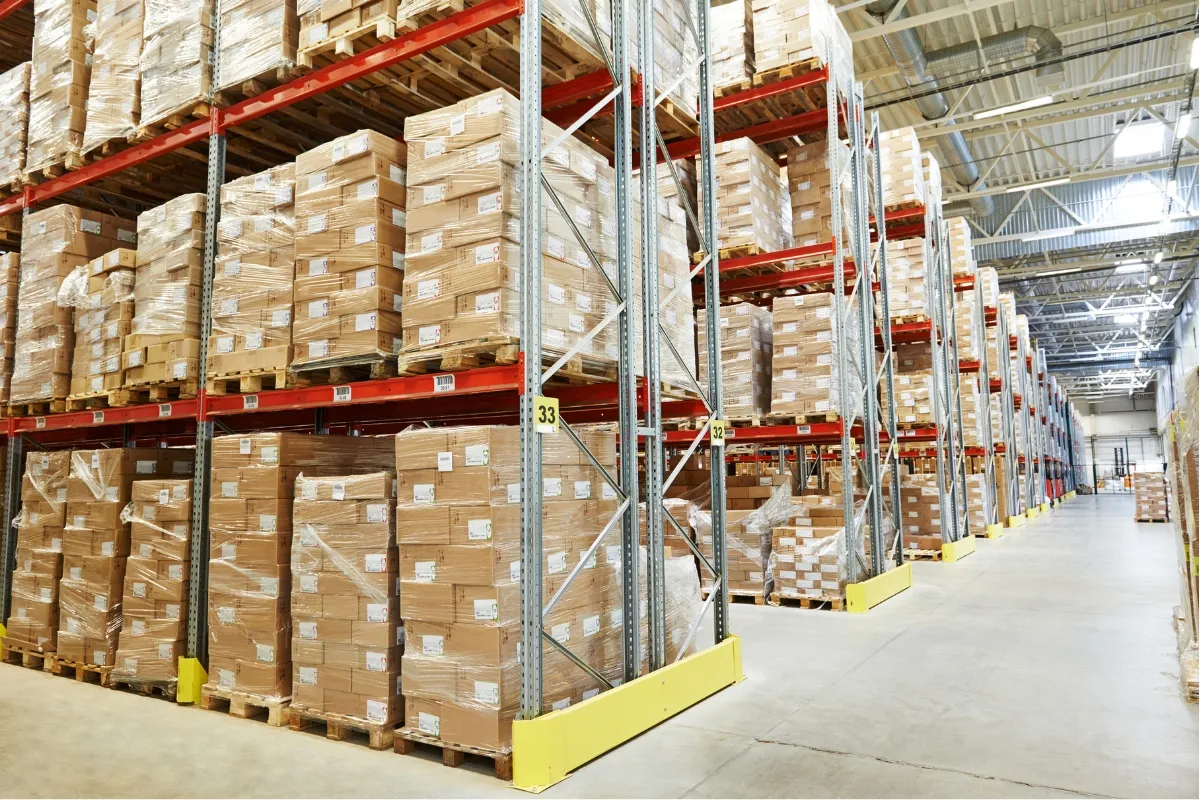
Whether it’s an e-commerce distribution center or a factory parts and materials warehouse, you need to invest in space planning and design tools to maintain safe, efficient, organized warehouse operations, as part of a more succinct value stream.
Modern warehouse layout design
The complexities of modern warehouses have less to do with how companies build them and more to do with how they manage them. Whether it’s pick-and-pack or ship-and-store, navigability and organization are the fundamental pillars of warehouse operations. Workers need to know exactly where they’re going and understand the best route to get there. This depends almost entirely on warehouse space planning.
Importance of space planning for warehouses: basic example
Consider the process of retrieving a single product. Green Widgets live on Aisle 12, Bay 22, on the sixth shelf. Right away, workers need to understand the product’s location and its context within the warehouse, which means having some form of wayfinding. Moreover, it’s vital to factor in the act of retrieval. For example, if Green Widgets weigh 150 pounds and are on the sixth shelf up, there needs to be enough room to operate a forklift in that space. Finally, there needs to be significance to why a product gets stocked in one location vs. another. Maybe Green Widgets are consumer appliances, and Bay 22 is where consumer appliances live.
What should you include in your warehouse layout?
There’s a myriad of variables that go into orchestrating a warehouse layout. It’s not enough to consider the products themselves. Space planners also need to consider stocking and retrieval, as well as maneuverability and navigability. In the end, your static warehouse space needs to support dynamic operations. So, you need to plan it all out carefully. When creating a warehouse layout, make sure to allocate space to support the following activities.
Storage and inventory areas
At the center of your success is how well you can store inventory. Closely consider what’s going on the shelves before deciding on racks and equipment.
Receiving docks
Before it can go on the right shelves, you need processes in place to unload products from delivery trucks so you can count and prepare it.
Picking and packing areas
Just as important as getting products in is getting them out. These areas are where employees fill orders and pack everything up. Depending on the warehouse, order picking can be highly automated or as low-tech as an employee walking between racks, collecting small items in a basket.
Shipping docks
Here, packers move individual orders to pallet racks, which they then load onto trucks for outbound shipping. Just like at the receiving docks, there’s a lot of paperwork involved to ensure the right products are heading to the right spots. So, the layout can include room not only for forklifts to operate but also desks and work terminals.
Office and employee spaces
These are the parts of the warehouse that could just as easily appear in other facilities. For example, restrooms, breakrooms, and cafeterias. In larger warehouses, there’s also dedicated office space for managers and other administrative staff.
How is warehouse utilization calculated?
With careful space planning comes the need to understand if your warehouse is efficient. That means taking a closer look at warehouse space utilization. Do you have space for everything you need to stock? More important, do you have the space necessary to house everything within the context of the organizational system you’ve developed? These are fundamental questions, and you can answer them only by observing key metrics of warehouse utilization.
Total warehouse size and storage capacity
Start with your total warehouse size in available cubic feet. Once you have the total square footage for the entire facility, you need to subtract everything that isn’t a storage space, including restrooms and office space. Take the remaining square footage and multiply it by the clear height of your warehouse. Remember, warehouses use vertical and horizontal space, so total cubic feet matter more than square footage.
Potential storage capacity
Here, you’re basing how much you can store on rack spacing. If you change the racks, you also change how much you can store on them. Multiply the length and width of your racking by the highest load height.
Space utilization
Next, calculate the inventory cube size. It’s a simple equation that involves adding up the volume of warehouse product and dividing it by the available cubic foot space.
Finally, establish acceptable margins of utilization. Zero percent utilization is an empty warehouse, while 100% utilization fills every cubic foot, which is impossible. In fact, once you get to 85%, you should consider your warehouse as out of space.
Industry metrics put average utilization rates for warehouses at between 22% and 27%, depending on the nature of operations. Below 22% utilization indicates you’re not using space efficiently. When you’re above 27%, you run the risk of overcrowding and potential stocking issues.
Tips to optimize warehouse space
Operational efficiency comes from warehouse space optimization. There are many different levers warehouse managers can pull to optimize floor plans, racking arrangements, and product layout.
Remember to use vertical space. Start with an efficient floor plan that utilizes square footage, then build up to capitalize on unused, unencumbered vertical cubic feet.
Create architecture that supports warehouse safety and follows all applicable guidelines and regulations, from forklift certifications to materials handling systems.
Implement a wayfinding system that’s intuitive and navigable, with proper signage and directional instructions. Make sure to post safety signage also.
Create a grid system to apportion warehouse equipment such as ladders, forklifts, skyjacks, and other essential equipment, to ensure it’s always accessible.
Centralize operations to bring conveyors and sorting equipment to the middle of inventorying systems. This is equally important for shipping, receiving, and sorting.
Establish material flow routes to prevent backups and space conflicts. This will help promote seamless movement in dynamic areas.
It’s critical to remember that warehouses feature static layouts within the context of a dynamic space. And, unlike offices or other commercial space, vertical height is usable space. Optimizing warehouse space is to make it easily navigable on a two-dimensional plane, while maximizing the capabilities of three-dimensional space.
Benefits of warehouse space planning software
Even within the context of smart environments, it’s easy to fall into the trap of thinking about warehouses as one big space. Warehouse managers can break this habit by relying on space planning software to help them delineate space into zones. Segmenting the warehouse and treating different zones as unique starts by identifying and managing them as separate entities. Space planning software provides a top-down view that does exactly that.
To understand warehouse space in the context of zones and needs is to run a more efficient environment. Whether it’s pick-and-pack operations or for inventorying purposes, a well-orchestrated warehouse promotes a more efficient value stream and better bottom-line performance.


